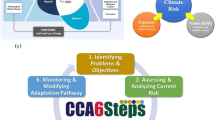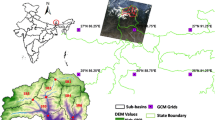Abstract
Changes in climate extremes may cause the variation of occurrence and intensity of floods and droughts. To investigate the future changes in joint probability behaviors of precipitation extremes for water resources management, an approach including three stages for analyzing the spatial variation of joint return periods of precipitation extremes is proposed in this paper. In the first stage, a weather generator model (WGM) was conducted with general circulation models (GCMs) under representative concentration pathway (RCP) scenarios to generate daily rainfall time series during 2021–2040 (S) and 2081–2100 (L) based on the statistics of the observed rainfall data. Four extreme precipitation indices are defined to represent extreme precipitation events. In the second stage, copula methods are adopted to establish the joint distribution of the precipitation extreme indices. The watershed-scale assessment of flood and drought applied in Shih-Men reservoir in northern Taiwan is conducted to demonstrate the possible change of joint return period. In the third stage, the change rates of joint return periods for bivariate extreme indices are demonstrated to present the occurrence possibility of floods or droughts in the future. The results indicate that floods and droughts might occur more frequently in the upstream region of the reservoir during the twenty-first century. The reservoir operations would be more important for water supply and flood mitigation. In conclusion, the possible changes of future joint probability of the precipitation extremes should be paid attention to for water resources management and draft plans to confront potential challenges in the future.








Similar content being viewed by others
References
Allen M, Ingram WJ (2002) Constraints on future changes in climate and the hydrologic cycle. Nature 419:224–232
Bacchi B, Becciu G, Kottegoda NT (1994) Bivariate exponential model applied to intensities and durations of extreme rainfall. J Hydrol 155:225–236
Bargaoui ZK, Bardossy A (2015) Modeling short duration extreme precipitation patterns using copula and generalized maximum pseudo-likelihood estimation with censoring. Adv Water Resour 84:1–13
Boelee E, Yohannes M, Poda JN, McCartney M, Cecchi P, Kibret S, Hagos F, Laamrani H (2013) Options for water storage and rainwater harvesting to improve health and resilience against climate change in Africa. Reg Environ Chang 13(3):509–519
Chang LC, Chang FJ (2001) Intelligent control for modelling of real-time reservoir operation. Hydrol Process 15(9):1621–1634
Duan K, Mei Y, Zhang L (2016) Copula-based bivariate flood frequency analysis in a changing climate-a case study in the Huai River basin, China. J Earth Sci 27(1):37–46
Easterling RD, Meehl AG, Parmesan C, Changnon AS, Karl RT, Mearns OL (2000) Climate extremes: observations, modeling, and impacts. Science 289:2068–2074
Fan YR, Huang WW, Huang GH, Huang K, Li YP, Kong XM (2016) Bivariate hydrologic risk analysis based on a coupled entropy-copula method for the Xiangxi River in the three gorges reservoir area, China. Theor Appl Climatol 125(1–2):381–397
Gohari A, Bozorgi A, Madani K, Elledge J, Berndtsson R (2014) Adaptation of surface water supply to climate change in Central Iran. Journal of Water and Climate Change 5(3):391–407
Guo A, Chang J, Wang Y, Huang Q, Guo Z (2017) Maximum entropy-copula method for hydrological risk analysis under uncertainty: a case study on the loess plateau. China Entropy 19(11):609
Immerzeel WW, van Beek LPH, Bierkens MFP (2010) Climate change will affect the Asian water towers. Science 328:1382–1385
Jeong DI, Sushama L, Khaliq MN, Roy R (2014) A copula-based multivariate analysis of Canadian RCM projected changes to flood characteristics for northeastern Canada. Clim Dyn 42(7–8):2045–2066
Jhong BC, Wang JH, Lin GF (2017) An integrated two-stage support vector machine approach to forecast inundation maps during typhoons. J Hydrol 547:236–252
Kao SC, Govindaraju RS (2007) A bivariate frequency analysis of extreme rainfall with implications for design. J Geophys Res-Atmos 112(D13):D13119
Kao SC, Govindaraju RS (2010) A copula-based joint deficit index for droughts. J Hydrol 380:121–134
Kusangaya S, Warburton ML, van Garderen EA, Jewitt GPW (2014) Impacts of climate change on water resources in southern Africa: a review. Phys Chem Earth 67–69:47–54
Laux P, Vogl S, Qiu W, Knoche HR, Kunstmann H (2011) Copula-based statistical refinement of precipitation in RCM simulations over complex terrain. Hydrol Earth Syst Sci 15(7):2401–2419
Lee CH, Kim TW, Chung GH, Choi MH, Yoo CS (2010) Application of bivariate frequency analysis to the derivation of rainfall-frequency curves. Stoch Env Res Risk A 24(3):389–397
Li JF, Zhang Q, Chen YD, Xu CY, Singh VP (2013) Changing spatiotemporal patterns of precipitation extremes in China during 2071-2100 based on earth system models. J Geophys Res-Atmos 118(22):12537–12555
Li JF, Zhang Q, Chen YD, Singh VP (2015) Future joint probability behaviors of precipitation extremes across China: spatiotemporal patterns and implications for flood and drought hazards. Glob Planet Chang 124:107–122
Lin GF, Jhong BC (2015) A real-time forecasting model for the spatial distribution of typhoon rainfall. J Hydrol 521:302–313
Lin CY, Tung CP (2017) Procedure for selecting GCM datasets for climate risk assessment. Terrestrial Atmospheric and Oceanic Sciences 28(1):43–55
Liu TM, Tung CP, Ke KY, Chuang LH, Lin CY (2009) Application and development of a decision-support system for assessing water shortage and allocation with climate change. Paddy Water Environ 7:301–311
Madadgar S, Moradkhani H (2011) Drought analysis under climate change using copula. J Hydrol Eng 18(7):746–759
Mazouz R, Assani AA, Quessy JF, Legare G (2012) Comparison of the interannual variability of spring heavy floods characteristics of tributaries of the St. Lawrence River in Quebec (Canada). Adv Water Resour 35:110–120
Mendes BVM, Souza RM (2004) Measuring financial risks with copulas. Int Rev Financ Anal 13(1):27–45
Mirza MMQ (2002) Global warming and changes in the probability of occurrence of floods in Bangladesh and implications. Glob Environ Chang 12:127–238
Nandintsetseg B, Greene JS, Goulden CE (2007) Trends in extreme daily precipitation and temperature near Lake Hovsgol, Mongolia. Int J Climatol 27(3):341–347
Nelsen RB (2006) Introduction to copulas. Springer-Verlag, New York
Richardson CW, Wright DA (1984) WGEN: A model for generating daily weather variables. United States Department of Agriculture, Agricultural Research Service, Washington, DC, USA
Salvadori, G., De Michele, C., 2004. Frequency analysis via copulas: theoretical aspects and applications to hydrological events. Water Resour Res 40 (12), W12511
Shiau JT, Feng S, Nadaraiah S (2007) Assessment of hydrological droughts for the Yellow River, China, using copulas. Hydrol Process 21:2157–2163
Sillmann J, Roeckner E (2008) Indices for extreme events in projections of anthropogenic climate change. Clim Chang 86(1–2):83–104
Taylor KE, Stouffer RJ, Meehl GA (2012) An overview of CMIP5 and the experiment design. Bull Am Meteorol Soc 93(4):485–498
Tong X, Wang D, Singh VP, Wu JC, Chen X, Chen YF (2015) Impact of data length on the uncertainty of hydrological copula modeling. J Hydrol Eng 20(4):05014019
Tung CP, Liu TM, Chen SW, Ke KY, Li MH (2014) Carrying capacity and sustainability appraisals on regional water supply systems under climate change. British Journal of Environment and Climate Change 4:27–44
van Vuuren DP, Stehfest E, den Elzen MGJ, Kram T, van Vliet J, Deetman S, Isaac M, Goldewijk SK, Holf A, Beltran AM, Oostenrijk R, van Ruijven B (2011) RCP2.6: exploring the possibility to keep global mean temperature increase below 2 °C. Clim Chang 109:95–116
Yoo J, Kim U, Kim TW (2013) Bivariate drought frequency curves and confidence intervals: a case study using monthly rainfall generation. Stoch Env Res Risk A 27(1):285–295
Yue S (2000) Joint probability distribution of annual maximum storm peaks and amounts as represented by daily rainfalls. Hydrological Sciences Journal-Journal Des Sciences Hydrologiques 45(2):315–326
Yue S (2001) A bivariate gamma distribution for use in multivariate flood frequency analysis. Hydrol Process 15(6):1033–1045
Yue S, Rasmussen P (2002) Bivariate frequency analysis: discussion of some useful concepts in hydrological application. Hydrol Process 16(14):2881–2898
Zhang L, Singh VP (2007) Bivariate rainfall frequency distributions using Archimedean copulas. J Hydrol 332(1–2):93–109
Zhang Q, Singh VP, Li JF, Jiang FQ, Bai YG (2012) Spatio-temporal variations of precipitation extremes in Xinjiang, China. J Hydrol 434:7–18
Zhang Q, Li JF, Singh VP, Xu CY (2013) Copula-based spatio-temporal patterns of precipitation extremes in China. Int J Climatol 33(5):1140–1152
Zhao P, Lü H, Fu G, Zhu Y, Su J, Wang J (2017) Uncertainty of hydrological drought characteristics with copula functions and probability distributions: a case study of Weihe River, China. Water 9(5):334
Acknowledgements
The authors are grateful to the Taiwan Climate Change Projection and Information Platform Project (TCCIP) funded by Ministry of Science and Technology (MOST) for providing the projections of general circulation models based on climate scenarios and revised by the method of bias correction and spatial disaggregation.
Author information
Authors and Affiliations
Corresponding author
Ethics declarations
Conflict of Interest
None.
Rights and permissions
About this article
Cite this article
Jhong, BC., Tung, CP. Evaluating Future Joint Probability of Precipitation Extremes with a Copula-Based Assessing Approach in Climate Change. Water Resour Manage 32, 4253–4274 (2018). https://doi.org/10.1007/s11269-018-2045-y
Received:
Accepted:
Published:
Issue Date:
DOI: https://doi.org/10.1007/s11269-018-2045-y




